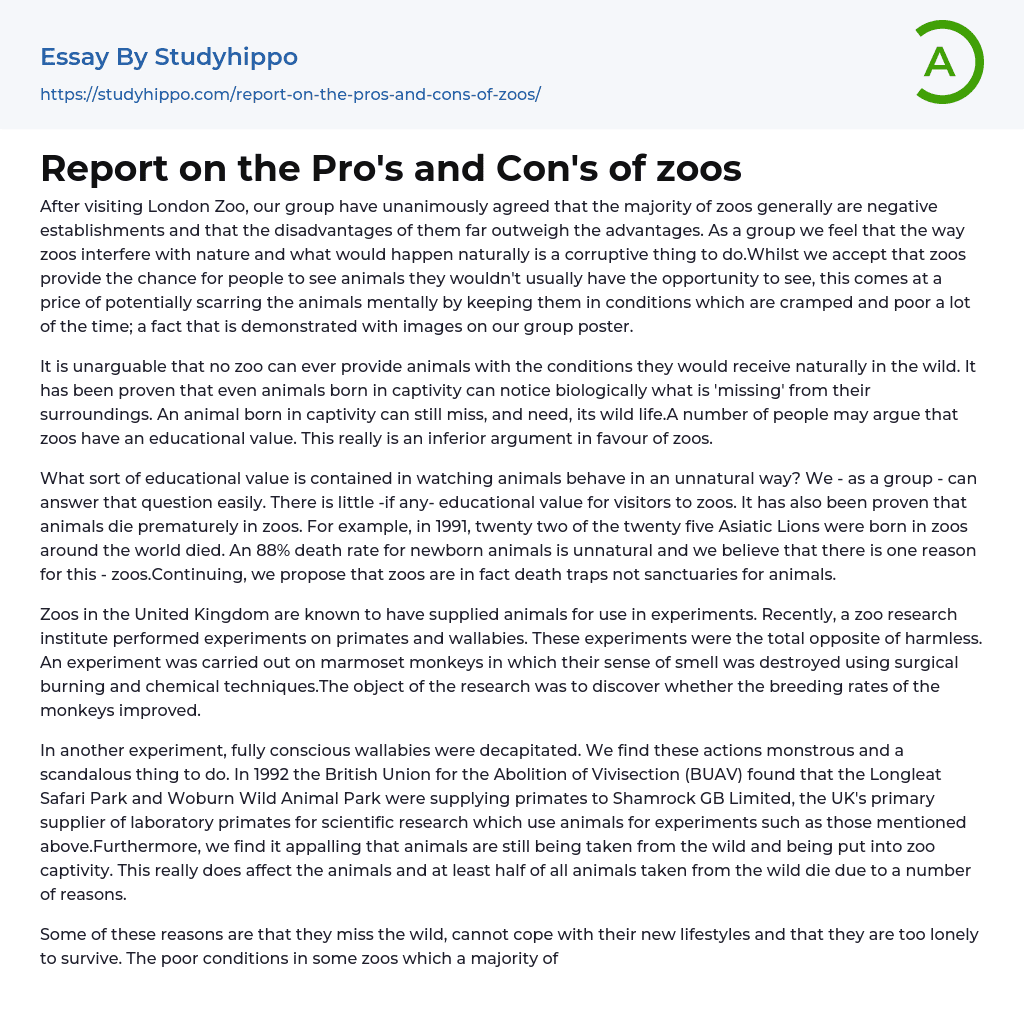Our group visited London Zoo and collectively concluded that zoos are predominantly harmful establishments, with drawbacks that outweigh the benefits. We believe that zoos disrupt nature and interfere with its natural course, which is corruptive. Although we acknowledge that zoos offer a chance to see exotic animals that people might not otherwise encounter, this comes at the cost of potentially traumatizing the animals by subjecting them to cramped and inadequate conditions. Our group poster visually illustrates this reality.
There is no doubt that zoos cannot replicate the natural conditions that animals would experience in the wild. Even animals born in captivity can perceive what is lacking in their environment. They may miss their natural habitat and require it. Some may argue that zoos have educational benefits, but this is a weak justification for their existence.
The educational worth
...of observing animals acting unnaturally is being questioned. As a group, we confidently state that there is very little, if any, educational benefit for guests visiting zoos. Furthermore, research shows that zoo animals have shorter lifespans. For instance, in 1991, out of twenty-five Asiatic Lions born around the world in zoos, twenty-two died - equivalent to an 88% death rate for newborns. We believe that zoos are to blame for this abnormality and submit that instead of sanctuaries, zoos are actually perilous environments for animals.
Recently, a research institute at a United Kingdom zoo conducted harmful experiments on primates and wallabies that were supplied by zoos for experimentation purposes. One of the experiments involved surgically burning and chemically manipulating the sense of smell of marmoset monkeys in order to investigate if their breeding rates would increase.
It is deplorable
that fully conscious wallabies were beheaded in a separate trial, an act that we regard as outrageous and shameful. In 1992, the British Union for the Abolition of Vivisection (BUAV) uncovered that Longleat Safari Park and Woburn Wild Animal Park were providing primates to Shamrock GB Limited, UK's primary distributor of laboratory primates for scientific research that employ animals in such experiments as those mentioned earlier. It is also beyond our comprehension that animals are still being caught from the wild to be confined in zoo enclosures. This has genuine consequences for the animals, with at least half of them dying due to a variety of factors.
Various reasons contribute to why certain animals find it challenging to survive in zoos, ranging from the absence of their native habitats, incapability to adjust to novel living conditions, and loneliness. Notably, numerous zoos encounter severe financial difficulties that lead to inadequate living standards for the animals. Some young elephants are transported from South Africa to the UK after witnessing the horrifying experience of their families being killed. In essence, many zoos prioritize their interests such as drawing crowds with famous animal species like giraffes, monkeys, tigers, and elephants rather than prioritizing genuine conservation or education.
The purpose of keeping animals in captivity in zoos is solely for the benefit of humans. Although visitors are drawn to seeing animals that have been bred and born in captivity, these creatures ultimately age and become less active, losing their attractiveness. Sadly, older animals are often either killed by shooting or sold into the pet trade. As an example, a team investigating animal welfare from CAPS found two Goeldi's marmoset monkeys at
a pet store in 1992; it was later revealed that they had originally come from a zoo.
Goeldi's marmosets are a rare primate species and it is the responsibility of zoos to protect endangered animals. However, getting rid of rare species may encourage their extinction, contradicting the very purpose of zoos. Unfortunately, some zoos suffer from staff shortages and inadequate knowledge and skills in animal care. For instance, Asia's largest zoo lacks a veterinary hospital and does not comply with legal requirements to have on-site veterinarians. These shortcomings and negligence in care contribute to animal deaths in zoos. Tragically, in 2003, a male tiger escaped an open cage and killed Badri, a 13-year-old tiger in an adjacent cage.
It is evident that the inadequacy of the staff and shortage of personnel have resulted in their negligent behavior. Despite the fact that zoos have negative connotations, we recognize that they offer some benefits. One of them being that they create awareness for the public and emphasize the need to protect endangered species by showcasing the animals. Additionally, protecting orphaned animals that would have otherwise perished is an essential and commendable function of zoos. Finally, there is praiseworthy scientific research conducted on animals in a non-invasive manner, which we believe is beneficial.
- Rabbit essays
- Distribution essays
- Large Animals essays
- Mouse essays
- Poultry essays
- Animal Abuse essays
- Cats Vs Dogs essays
- Cattle essays
- Territory essays
- Agriculture essays
- Albert einstein essays
- Animals essays
- Archaeology essays
- Bear essays
- Biology essays
- Birds essays
- Butterfly essays
- Cat essays
- Charles Darwin essays
- Chemistry essays
- Dinosaur essays
- Discovery essays
- Dolphin essays
- Elephant essays
- Eli Whitney essays
- Environmental Science essays
- Evolution essays
- Fish essays
- Genetics essays
- Horse essays
- Human Evolution essays
- Isaac Newton essays
- Journal essays
- Linguistics essays
- Lion essays
- Logic essays
- Mars essays
- Methodology essays
- Mineralogy essays
- Monkey essays
- Moon essays
- Mythology essays
- Noam Chomsky essays
- Physics essays
- Plate Tectonics essays
- Progress essays
- Reaction Rate essays
- Roman Numerals essays
- Scientific essays
- Scientific Method essays




